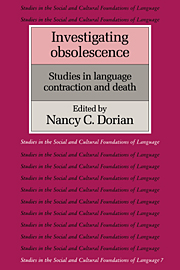Book contents
- Frontmatter
- Contents
- List of maps
- List of contributors
- Preface
- Map
- Dedication
- Introduction
- I Focus on context
- 1 On language death in eastern Africa
- 2 The disappearance of the Ugong in Thailand
- 3 Scottish and Irish Gaelic: The giant's bed-fellows
- 4 The rise and fall of an immigrant language: Norwegian in America
- 5 Breton vs. French: Language and the opposition of political, economic, social, and cultural values
- 6 “Persistence” or “tip” in Egyptian Nubian
- 7 Sociolinguistic creativity: Cape Breton Gaelic's linguistic “tip”
- 8 Skewed performance and full performance in language obsolescence: The case of an Albanian variety
- 9 On the social meaning of linguistic variability in language death situations: Variation in Newfoundland French
- 10 The social functions of relativization in obsolescent and non-obsolescent languages
- II Focus on structure
- III Invited commentaries
- Bibliography
- Index of languages
- General index
2 - The disappearance of the Ugong in Thailand
Published online by Cambridge University Press: 08 January 2010
- Frontmatter
- Contents
- List of maps
- List of contributors
- Preface
- Map
- Dedication
- Introduction
- I Focus on context
- 1 On language death in eastern Africa
- 2 The disappearance of the Ugong in Thailand
- 3 Scottish and Irish Gaelic: The giant's bed-fellows
- 4 The rise and fall of an immigrant language: Norwegian in America
- 5 Breton vs. French: Language and the opposition of political, economic, social, and cultural values
- 6 “Persistence” or “tip” in Egyptian Nubian
- 7 Sociolinguistic creativity: Cape Breton Gaelic's linguistic “tip”
- 8 Skewed performance and full performance in language obsolescence: The case of an Albanian variety
- 9 On the social meaning of linguistic variability in language death situations: Variation in Newfoundland French
- 10 The social functions of relativization in obsolescent and non-obsolescent languages
- II Focus on structure
- III Invited commentaries
- Bibliography
- Index of languages
- General index
Summary
The Ugong speech community in western Thailand has been in decline ever since it was first reported, by a surveyor (Kerr 1927); he said that the language was on its last legs in the 1920s. The anthropologist Theodore Stern encountered this group in the 1960s and found the language very moribund (pers. comm.). In a series of visits beginning in 1977, I have found several locations where the language is still regularly used, even by some second-language speakers; but indeed it is virtually dead in the two locations found by Kerr, one of which was also visited by Stern. The language is in the Burmic subgroup of the Tibeto-Burman family.
Factors contributing to language maintenance in the surviving locations are various; some or all of these factors are absent in the other former locations. The political prestige and individual dynamism of recently deceased headmen, though in decline as the Ugong area became settled by Thais, was a major factor in two cases, but failed to promote Ugong in a third where other negative factors were present. Geographical isolation and lack of schools, economic independence, and continuing in-group contacts were all also favorable to Ugong in the same two locations until very recently. Now roads, schools, cash crops, and large-scale influx of Thais have changed this. Another negative factor has been extensive marriage with other groups, partly due to a lack of suitable Ugong spouses as the community contracted. There is a strong stigma in Thailand attached to minority status; some of the effects are noted below (p. 39); Ugong are beginning to feel this stigma increasingly strongly.
- Type
- Chapter
- Information
- Investigating ObsolescenceStudies in Language Contraction and Death, pp. 33 - 40Publisher: Cambridge University PressPrint publication year: 1989
- 10
- Cited by

